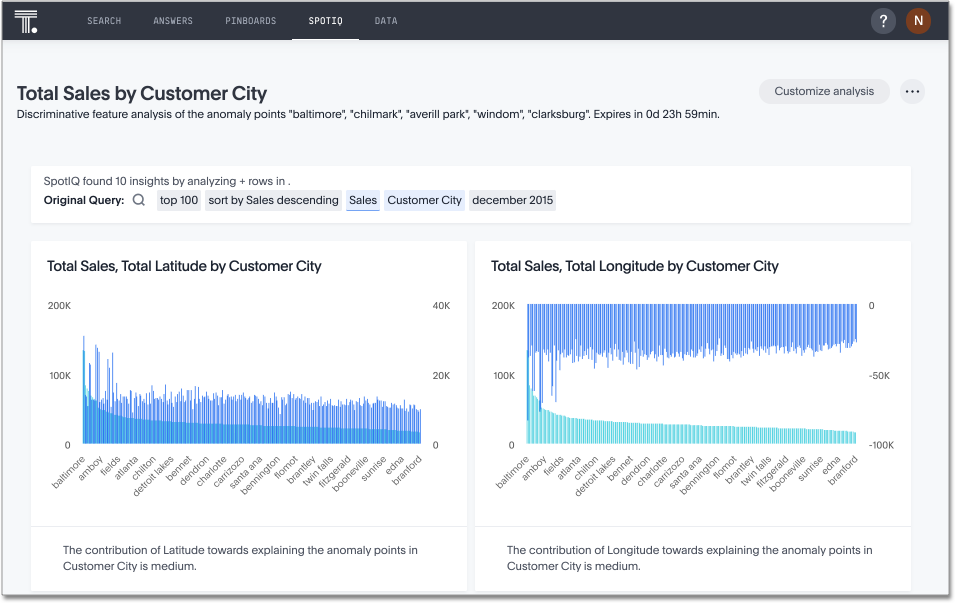Everywhere in ThoughtSpot where you can run SpotIQ analyze, you can configure a customized SpotIQ analysis. The customized analysis can be a one-time customization or can apply to all future analysis of that particular data source.
Finding customization controls
Every menu or location where you can run SpotIQ analyze, you
can customize your analysis. You access it using the lightbulb button ![]() or the ellipses menu
or the ellipses menu ![]() .
.
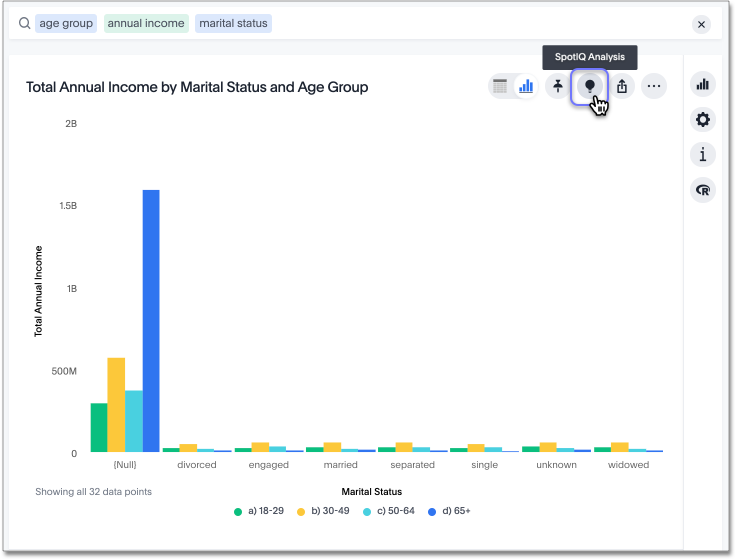
SpotIQ window layout
Depending on where you run SpotIQ analyze in ThoughtSpot, the SpotIQ window has a different layout.
SpotIQ from an Answer or search
-
When you access it from an Answer or search, the SpotIQ window first asks you what kind of analysis you would like to do:
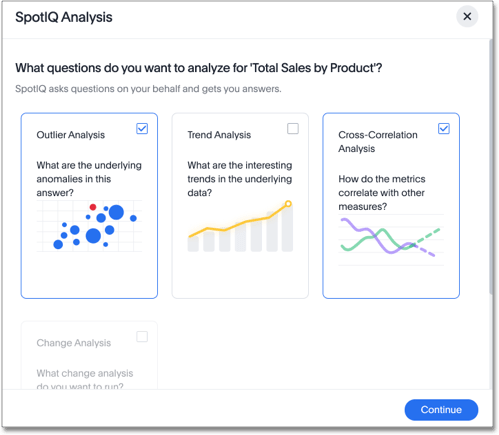
- Outlier analysis: finds underlying anomalies or outliers in the Answer
- Trend analysis: finds interesting trends in the Answer’s underlying data
- Cross-correlation analysis: determines how your metrics correlate with other measures
- Change analysis: if you select 2 or more data points, you can run a change analysis on those points. Otherwise, ThoughtSpot does not allow you to click on this option.
-
Next, SpotIQ recommends certain columns for analysis. You can select all columns in the Answer, clear all columns, or search for more columns to include.
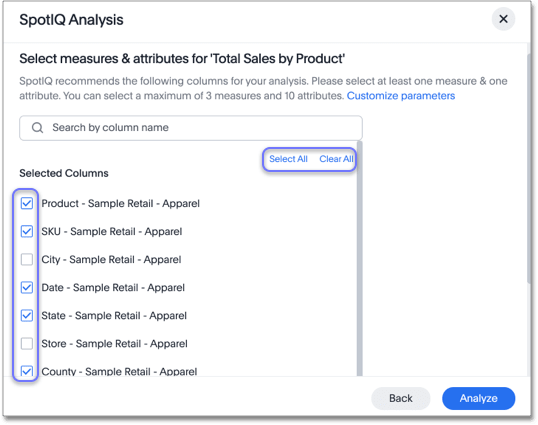
-
You can also customize advanced parameters. Select Customize parameters, on the Select measures and attributes page. The following screen appears. Scroll down to see more options, including customizations for specific analysis types.
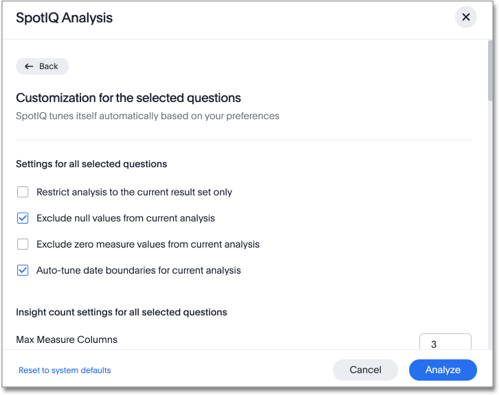
You can customize the following parameters for any SpotIQ analysis except a change analysis:
- General settings: exclude null values, restrict analysis to the current result set only, exclude zero values, or auto-tune date boundaries
- Insight count settings: choose the maximum number of measure and attribute columns to analyze
You can customize the following parameters for an outlier analysis:
- Outlier algorithm: choose the method of outlier detection (z-scores or median z-scores, Seasonal Hybrid ESD, or Linear Regression)
- Outlier parameters: choose the minimum rows required for analysis, multiplier for outlier detection, and maximum P-Value
- Insight count settings: choose the maximum outlier detection insights, maximum seasonality detection insights, and maximum linear regression insights
You can customize the following parameters for a trend analysis:
- Trend parameters: specify the minimum rows required for analysis, maximum P-Value, and minimum relative difference
- Insight count settings: specify the maximum trend insights
You can customize the following parameters for a cross-correlation analysis:
- Cross-correlation parameters: choose the minimum rows required for analysis, minimum correlation coefficient, maximum correlation coefficient, and maximum correlation lag
- Insight count settings: choose the maximum cross-correlation insights
You can customize the following parameters for a change analysis:
- Change analysis parameters: specify the maximum difference elements, the maximum fraction, minimum abs change ratio, and minimum change ratio
You can also reset these parameters to their system defaults. Select Reset to system default in the bottom left corner of the SpotIQ modal.
-
Select Analyze.
SpotIQ from a Liveboard
When you access it from a Liveboard, the SpotIQ window has two tabs:
- Columns, where you can explicitly indicate which columns to include in a SpotIQ analysis. (You can select all, some, or none.)
- Advanced, where you can run custom analyses and incorporate R scripts into SpotIQ.
The Advanced tab has many options. The panel scrolls, so more algorithms are available than appear in the following image

The SpotIQ insights page has an option to open this window to customize a single analysis.

The Tell us more window provides information on how to exclude a value from all future analysis.

Eliminate null values
Null values should be eliminated from your analysis.
| From next analysis | From future analyses |
|---|---|
|
In the Search bar, add a filter |
Set Exclude null values from my analysis on your user Profile to exclude them from any future SpotIQ analyses you do. |
Exclude uninteresting column(s) in insight
You should always exclude columns you are not interested from your analysis.
| From next analysis | From future analyses |
|---|---|
|
Use the EXCLUDE option of SPOTIQ PREFERENCE under the DATA tab to exclude any column permanently from all future analysis. |
Include an interesting column
You can always include columns that interest you in your analysis.
| From next analysis | From future analyses |
|---|---|
|
Choose Customize analysis and select columns that you want to include. |
Ensure Index Priority is between 8-10 on the column under the DATA tab. |
Remove known date outliers
Your data may contain known outliers. For example, you are in the middle of a quarter and only want to analyze the previous quarter. Anything from the present quarter could contain an outlier.
| From next analysis | From future analyses |
|---|---|
|
In the Search bar, add a filter |
Not applicable. |
Too few insights
Your SpotIQ analysis may not provide you as many insights as you think it should.
| From next analysis | From future analyses |
|---|---|
|
Choose Customize analysis, select the Advanced tab, and decrease the Multiplier for Outlier Detection to a value closer to zero. |
Not applicable. |
Explaining Anomaly Insights
When SpotIQ finds insights with anomaly points, you have the option to run the Explain Insight command to have SpotIQ do further analysis on the anomaly points.
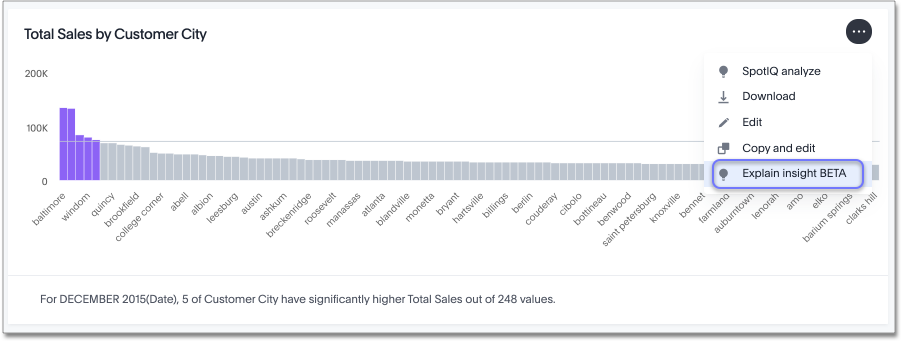
To explain an insight, do the following:
-
Click the ellipses icon
 for the insight you want to explain and select Explain insight.
for the insight you want to explain and select Explain insight. -
In the SpotIQ window, click Analyze.
Analysis begins.
-
Click SpotIQ in the top navigation bar.
-
Click the Analyses tab.
-
Find the name of the insight that you analyzed and click View Results.
The results of your insight analysis explaining your anomaly points appear.
